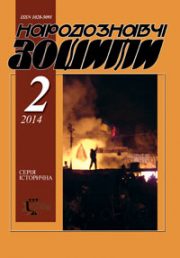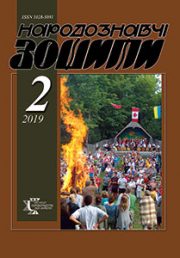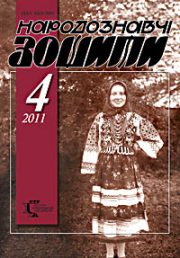The Ethnology Notebooks. 2024. № 6 (180), 1563—1575
UDK 75.036.5/.7(477.83/.86)”19″Новаківський О.
DOI https://doi.org/10.15407/nz2024.06.1563
OLEKSA NOVAKIVSKY: SYNTHESIS OF EXPRESSION AND COLOR
MAKOYDA Orest
- ORCID ID: http://orcid.org/0000-0001-6915-2481
- Candidate of Sciences in Arts (Ph.D), Head of Department,
- The Institute of Ethnology of the National Academy
- of Sciences of Ukraine,
- Department of Folk Art,
- 15, Svobody Avenue, 79000, Lviv, Ukraine,
- Contacts: e-mail: orestmakoyda@gmail.com
Abstract. Introduction. Among the Ukrainian artists of the beginning of the 20th century, there were those who were directly related to the expressionist movement:, George Narbut, Vasyl Kandinsky, David and Volodymyr Burlyuk, Volodymyr Izdebsky, Oleksandra Ekster (Gryhorovych), Sonia Delaunay and others. These masters played an important role in artistic expressionist searches and the formation of a new Western European direction. The other group includes artists who did not belong to expressionist associations, but expressive features of expressionism are visible in their work. This list includes Oleksa Novakivskyi, Kazimir Sihulskyi, Osip Soroktei, Ivan Rubchak, Leopold Levytskyi and a whole list of original Galician masters. A special place in this list is occupied by Lviv artist Oleksa Novakivskyi. Undisguised features of expressionism are visible in many of his works. The analysis of the master’s works and the determination of the ways in which expressionist stylistics penetrated his work will help to create a complete picture of the formation of the phenomenon in Ukrainian art.
The purpose of the article is to consider the cultural and artistic processes associated with the emergence of the expressionist movement in Galicia at the beginning of the 20th century. The primary task was the research of the work of the Lviv master painter Oleksa Novakivskyi and the identification of expressionist features in his works.
Conclusion. Expressionism was not a temporary phenomenon in Oleksa Novakivskyi’s work. Many factors became the basis for the formation of the artist’s expressionistic worldview. The initial stage of the formation of expressionist foundations falls on the Krakуw period. While studying and living in Poland, the artist had the opportunity to get acquainted with popular direction of expressionism. The expressionist direction had a rather noticeable resonance in the Polish artistic environment of the beginning of the 20th century. At an early stage, the Ukrainian artist’s dramatic and expressive painting was close to the work of Jacek Malchevskyi and Stanislav Wyspianskyi, but later the artist managed to create his own stylistic manner. Formally and emotionally, this manner was close to the work of the masters of expressionism.
In the works of Oleksa Novakivskyi, he uses techniques characteristic of expressionist circles — primarily hyperbolization and violation of proportions. Important in this sense is also the emotional subtext, which is most characteristic of the expressionist orientation.
The plot is close to the artist, capable of conveying states of the highest exaltation. Emotional subtext is present in many works of the master. They are present in works that convey the tragedy of war, in religious paintings and even in everyday scenes.
Keywords: expressionism, Galicia, Lviv, Krakow, artists, art groups, stylistics.
Received 5.11.2024
REFERENCES
- Ripko, O. (1995). In search of the executed past: Retrospective of artistic culture of Lviv in the 20th century (P. 72). Lviv: Kamenyar [in Ukrainian].
- Gorbachev, D.O., & Kudrytskyi, A.V. (1995). «Artes». Art of Ukraine. Encyclical.: in 5 vol. Kyiv: Ukrainian encyclopedia named after M.P. Bazhan [in Ukrainian].
- Ovsiychuk, V. (1998). Oleksa Novakivskyi (P. 28). Lviv: Institute of Folklore of the National Academy of Sciences of Ukraine [in Ukrainian].
- Aseeva, N.Yu. (1989). Ukrainian art and European art centers of the late 19th — early 20th centuries. Kyiv: Naukova dumka [in Russian].
- Golubovskyi, I. (2002). With the sweep of mighty wings. A story-essay about Oleksa Novakivskyi. Lviv: Az-Art [in Ukrainian].
- Voloshyn, L. (2001). Princely gift of a great patron: Metropolitan Andrey Sheptytskyi in the life and work of Oleksa Novakivskyi. Lviv [in Ukrainian].
- Richard, L., & Tolmachev, V.M. (2003). Encyclopedia of Expressionism: Painting and Graphics. Sculpture. Architecture. Literature. Dramaturgy. Theater. Movie. Music (Pp. 32—40). Moscow: Republic [in Russian].
- Dragan, M. (1931, 18—20 october). The first exhibition of ANUM. Business [in Ukrainian].
- Wildenstein, Daniel. (2022). Monet. The Triumph of Impressionism. Taschen GmbH.
- Aragon, L., & Zonina, L.A. (1973). Henri Matisse: in 2 books. Mosсow: Progress [in Russian].







